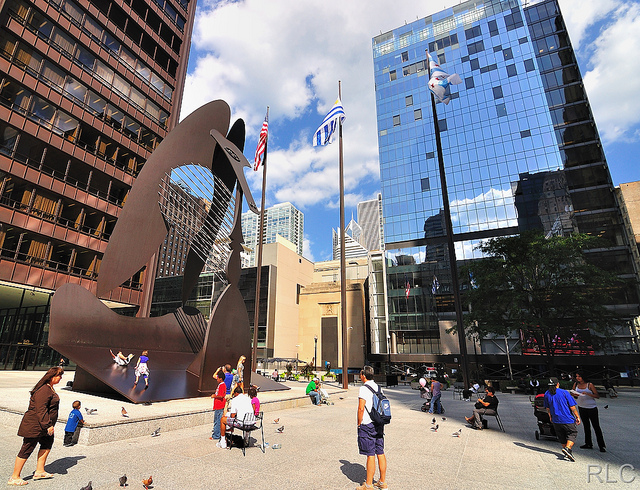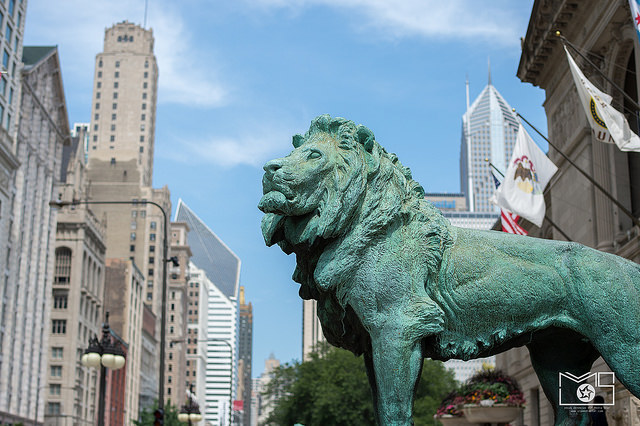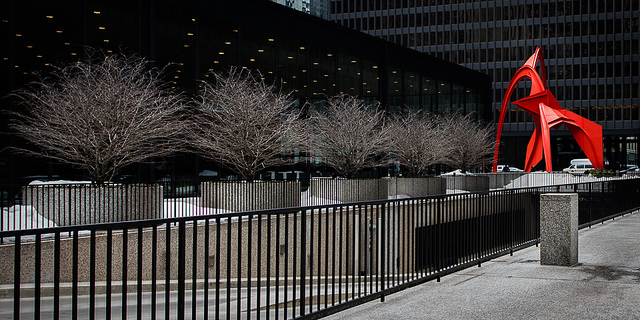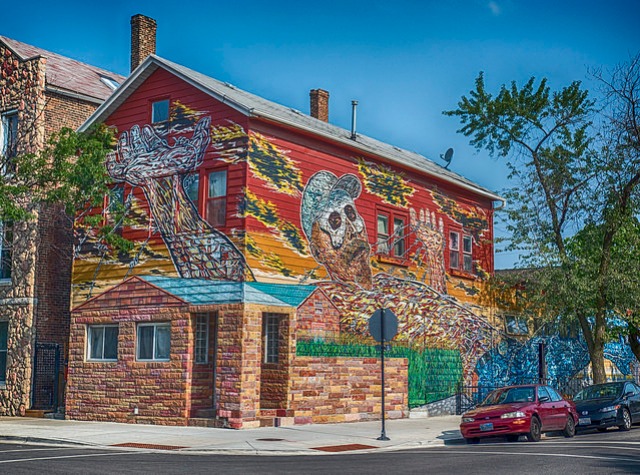The 10 Best Street And Public Art Pieces In Chicago
By Lisa White in Best Of on Apr 16, 2015 7:20PM
Like any major metropolis, Chicago has a wonderful array of art mixed into our city. You see it on your walk to work, passing by while riding the CTA and plastered throughout our many neighborhoods. Public art is a vital part of what makes our city beautiful, creative, inviting and unique.
One list alone can't contain all the wonderful public art you'll find around Chicago, especially since some of the phenomenal talent that brightens our streets is temporary. But we've compiled a list of our favorite permanent pieces, a good place to start if you want to revisit an old favorite or explore new works.
Make sure to check out the city's public art website for more suggestions, including a few favorites that didn't make the cut on our list (Agora and Chagall's Four Seasons are two that come to mind) and keep an eye out while commuting around the city because you'll never know what beautiful art you'll find.
The Picasso
Love it or hate it, “The Picasso” an untitled gift from the artist to the people of Chicago, is one of the most iconic pieces of public art in the city. And one that I personally have a soft spot for. First off, we have our own massive Pablo Picasso sculpture just plopped down in the middle of our lovely Chicago that you (ok, mostly tourists) can slide down. That in itself is pretty awesome. But the history of the sculpture, the fact that Picasso (per usual) gave no care what people thought and NEVER explained what the piece was suppose to represent makes it even more badass. Commissioned in 1963, Picasso worked for two years, combining his style from earlier works and taking parts of original sketches, before he finally presented a 42-inch tall model of what he envisioned for the piece. The sketches and model are still on display at the Art Institute of Chicago today. The steel statue was unveiled in 1967 and has become an icon that many worldwide associate with our city. During warmer weather you can watch children playing on it, it’s a perfect meeting spot downtown and it watches over our city during all the events that happen at Daley Plaza, quizzically observing our city with all its abstract glory. — Lisa White
The Picasso is located at 50 W. Washington St.
Richard Hunt’s We Will Sculpture
Richard Hunt's 2005 public sculpture, We Will, sits near the Randolph Street entrance to the Chicago Cultural Center. Grandiose like most of Hunt's recent work, it reaches upward as a lush quotation of the vertical architecture that surrounds it. The work is a statement of permanence and determination, strength and awe. Its positioned near the entrance to Millennium Station and has close proximity to Millennium Park, standing as an integral element within The Loop's well-curated cultural landscape. Hunt himself is a quintessential artist of the city and this sculpture attests to his timeless significance. — Carrie McGath
Richard Hunt's We Will sculpture is located at the corner of Randolph St. and Garland Ct.
Edward Kemeys' The Lions
Honestly, the two lions that guard the main entrance of The Art Institute of Chicago serve as a great opening piece before going into the museum itself. Looking strong, defiant and majestic, they have stood at their perches since 1893, making them one of the oldest displays of public art in this city. They’re also a fixture in our sport scene, adorning Bears and Blackhawks helmets when the time is right and our team is on a roll. Plus, they make a cameo in the Bulls epic kick off video before the starting lineup is introduced. If there is anything that can beat the Bean or Picasso in the loop, it’s these big cats. — Ben Kramer
Edward Kemeys' The Lions are located in front of The Art Institute of Chicago at 111 S. Michigan Ave.
Wyatt’s Wall
Residents of Hyde Park are probably familiar with Wyatt’s Wall, whether they know it by name or not. The mural, located on the west wall of the alley beside the FedEx store on 57 St., is dedicated to the memory of Wyatt Mitchell. Wyatt, who was better known by most as Attica, was one of the most prolific taggers on the city’s South Side during the '90s and later became a member of the underground rap group Stony Island. Though Stony Island’s fans might have been concentrated to a small band of locals, the group soon attracted attention from a little New York based act you might have heard of called The Beastie Boys. Unfortunately Wyatt passed away of an accidental drug overdose, but those who knew him refused to let that be his legacy. South Side Weekly wrote a beautiful profile on Wyatt last year to mark the 10th anniversary of his passing. — Sophie Day
Wyatt’s Wall is located at 1313 E. 57th St.

One of Jim Bachor's 2015 ice cream mosaics./ Photo courtesy of Jim Bachor
Transforming potholes into public works of art featuring colorful mosaics of the Chicago Flag, flowers and even the phone numbers for local car repair shops, Jim Bachor’s work definitely covers new ground. A successful Kickstarter campaign launched earlier this year raised just over $4,500 which will fund the artist’s 2015 Pothole Project, an installation of eight ice cream-themed pieces. (Hello, Yellow Brickle Road!) The first mosaic in this series was installed April 1 in West Town at Grand Ave. and Bishop St. Each installation is composed of fine art glass and marble and costs about $100 to complete. Since May 2013, Bachor has installed 12 pieces of pothole art and in June 2014 he installed a mosaic, “Thrive,” on the walls of the CTA’s Thorndale Red Line station. In Bachor’s hands, Chicago potholes are portholes to beauty—and after the ravages of this winter, we need it. — Tony Peregrin
Jim Bachor's pothole pieces are located throughout the city of Chicago.
Anish Kapoor's Cloud Gate
Upon first view of the stainless steel structure summoning visitors to pristine Millennium Park, one thinks, “Hey! That looks like a…” I don’t have to say it. Visitors and green Chicagoans are, dare we say, 100 percent of the time introduced to this now iconic piece by its affectionate nickname— The Bean. Surely its creator, acclaimed British sculptor Anish Kapoor, does not sanction such terms of endearment. A bean, yes, but its shape and shockingly seamless construction intends to mirror the beauty of the city’s skyline and, yes, the clouds. At 110-ton with a 12-foot-high arch, a view from afar does not do justice to the calculated elegance Kapoor’s first stateside sculpture, inspired by liquid mercury, lends up close and personal. Visiting when attending a concert at Jay Pritzker Pavilion or another fabulous exhibit at The Art Institute of Chicago, or merely indulging out-of-town guests, deep down we all love a little Bean in our lives. — Kristine Sherred
Cloud Gate, or The Bean, is located at Millennium Park at 55 N. Michigan Ave.
Calder’s Flamingo
Alexander Calder’s Flamingo piece rises up amongst the cold, stark Bauhaus style federal buildings surrounding it, an explosion of red and steel that makes it feel both a stranger in a strange land but also like it belongs within this industrial landscape. I’ve heard it referred to (with love) as the big red spork or that red alien looking thing but whatever you see in it, it sure does make for a beautiful photograph and a pop of color as you pass through our concrete jungle. Its open design welcomes exploration and to take in the view from every angle. It reminds me of an alien spaceship landing in our city, something curious and strange that always makes me smile when I pass by. For something so simple in design, it has endless possibilities for imagination (ask a kid what they see, you’ll likely get a delightful answer) and that is what I feel makes a strong piece of public art. — Lisa White
Calder’s Flamingo is located at 50 W. Adams St.
Skokie Northshore Sculpture Park
I already know what you’re thinking—Skokie?! Yes, this sculpture park is in the 'burbs but it’s unlike any in the Chicagoland area as one of the sole free, year-round, permanent installations of beautiful works that stretches for two whole miles. The park runs along McCormick Boulevard (from Dempster to the north and Touhy to the south) with dedicated walking and bike paths and seating areas, so you can make a day of it by taking a bike ride up there and enjoying the whole stretch. Started in 1988 by a group of private citizens, there’s more than 70 large- scale contemporary pieces created by noted regional, national and international artists. Roughly a quarter are permanent while other pieces rotate out—artists featured include Sasha Reid, Ted Gall, Andy Zimmerman and Jerry Peart. —Selena Fragassi
Skokie Northshore Sculpture Park is located in Skokie. Check their website for directions on visiting the full two mile expanse.
Pilsen Murals
If you love exploring and finding art on foot, Pilsen is one of the best places in the city to visit. Besides being a wonderful neighborhood full of amazing food and culture to enjoy, it also has some of the most beautiful murals in Chicago, from elaborate, massive works to intricate mosaics. Originally a collaboration between Chicago Urban Society, the National Museum of Mexican Art and Park Works, the murals of Pilsen have outgrown the original project and sanctioned works blend together with some incredible street art on the fly throughout the neighborhood. One of our favorite pieces is artist Hector Duarte’s house, which you can see above, that he’s turned into an outstanding piece of public art. Head south and spend the day hitting the pavement and exploring the murals of Pilsen. Check out the video below for a guided tour of some of the art throughout the neighborhood. — Lisa White
The Pilsen murals are located throughout the Pilsen neighborhood. Hector Duarte’s house is located at 1900 W. Cullerton St.
Frankie Knuckles mural
Street art, for the most part, is ephemeral. It’s kinda always been like that though. From TAKI 183 taking over NYC’s subways in the '70s to the modern global force known as Banksy, a tradition has always been in place. The artist creates something, the city takes it down and the piece lives on in photographs. We interact with street art slightly differently now, interactions changing from Polaroid pictures to Instagram and increasingly legal murals.
When house music icon Frankie Knuckles died last year, the city was grieving. The Artistic Bombing Crew, one of Chicago’s original graffiti crews who date back to the late '70s, decided to paint a mural in honor of him. The mural is placed on the roof of X-It European Clothing on Fullerton in Logan Square. It's a calming shade of blue with Knuckle's name in triumphant bold lettering next to a graphic of his face and turntables. It honors a true Chicago inspiration and is seen by thousands of people every day on the Blue Line in between the California and Logan Square stations.— Justin Freeman
The Frankie Knuckle's mural is located on the rooftop of X-It European Clothing at 2950 W. Fullerton. You can see the mural while riding the CTA Blue Line between the California and Logan Square stops.



